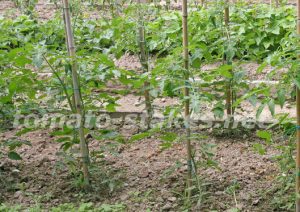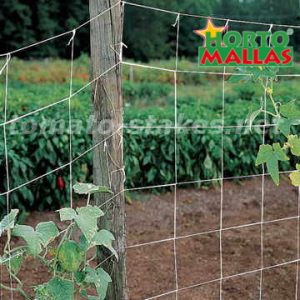The Purpose of Tomato Stakes
Driving a stake into the ground is a simple way in keeping the growth of tomatoes upright. This method is usually the easiest to start although it requires the most effort to maintain. During the plants’ active growth on the tomato stake, it is important to check it daily as they grow. A gardener must keep watch as the plants grow so they could tie and retie them into the stake. Tie the plants tightly and securely enough in order for the weight of the fruit to not pull the stake down, but not too tightly to avoid unwanted damages to the plant. The height of the stake should also correspond to the full grown size of the plant. Normally, stakes need to be at least 6 to 8 feet tall, regardless of the variety of the tomato being grown, with a foot or so on the ground to maintain stability.

Tomato stakes could be made from wood, plastic, or bamboo tomato stakes. Spiral and self-supporting tomato stakes are also available at hardware stores and nurseries. Furthermore, the stake could also be constructed from other materials like a pipe or scraps left in the house, as long as it is capable of doing the job.
In spite of other methods requiring less work like using a tomato trellis, a tomato ring, or a tomato cage, a tomato stake sacrifices it by being less expensive. Staking tomato plants properly would help them on surviving and thriving throughout the season to deliver those crops of fresh, ripe tomatoes when the harvesting time arrives. With the position the fruits grow into, it is easier to maintain their cleanliness and avoid diseases and infestation from insects, bugs, and other pests. It would be easier for them to be sprayed and be monitored for other various problems.
How to Set Up a Tomato Stake
Gather the materials, including ties, hammer or a mallet, and of course, the tomato stakes. Choose an appropriate stake and have the full grown size of the plant in mind to determine the right height needed.
Either immediately after planting the tomatoes or shortly after, hammer the stake into the ground immediately. Make sure the spot taken is stable and avoid hurting the roots of the plants. It is recommended to position the stake 3 to 6 inches away from the plant.

Using a hammer or a mallet, pound the stake into the ground and be sure that it is stable and secure. Choose strong and durable ties. You can use a variety of material for the ties. Cloth knit material can serve as very good ties. String or rope that isn’t too thick could also work well.
Wait for a strong enough stem to grow, usually when the first flower arrives, before tying the plant into the stake. Start with the main stalk. Be careful in tying the plant and remember that tomato plants are fragile so make sure to be gentle in the process. Loosely tie the plant into the stake close into the ground. Do not pull too hard but be sure to keep the knot strong.
As the plant grows, tie the branches together with the new growth in the main stalks. Regularly check and tie new growth before they could droop, grow outward or touch the ground.